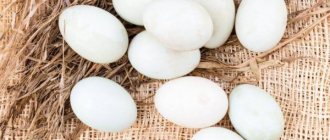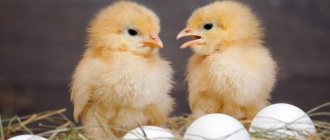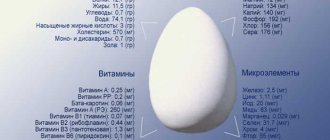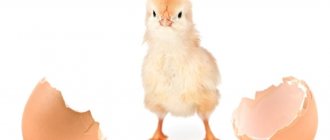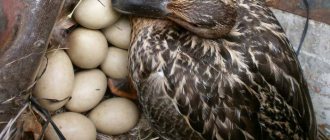Signs of impending masonry
A little about egg maturation
It takes a chicken about a day to create one egg.
The article “How Chickens Lay Eggs” describes the detailed process of egg formation. Next we will consider only the main points. The “birth” of a testicle begins with the ovary. The yolk descends into the oviduct, where it is covered with a protein layer. This process is the longest, taking approximately 20 hours.
In the oviductal isthmus, the yolk-white mass is covered with a pre-shell film. And already in the uterus - a full-fledged shell.
The last phase is coating with a protective film. 30-40 minutes after the egg is released through the cloaca, the process starts again.
Number of eggs from different breeds
The first eggs of pullets are modest in size - about 30-45 grams. After 2-4 weeks, their weight reaches 55-65 grams.
Egg-type chickens are capable of producing 250-300 eggs per year. There are also record holders who give much more.
Records of egg-meat birds - 140-180 pieces.
The annual number of eggs from meat layers does not exceed 120-150 pieces.
The article “How many eggs does a laying hen lay per day, month and year” will help you understand the egg production rates of chickens of all types. Including decorative, fighting and singing ones.
How to understand that a laying hen will soon give an egg
To understand whether a particular hen will start laying eggs, you can test it in several ways. This will help determine whether it is worth growing further. Or better yet, send it to slaughter.
The back of a good laying hen is strong and short.
The comb, lobes and earrings are secondary sexual characteristics that change color when the ovaries of chickens are activated. They become bright. And also smooth, soft and warm to the touch.
Pullets preparing to lay eggs have light and tender skin. It differs sharply from the bluish, rough skin with fat of a non-laying bird.
Other signs
During egg production, all the pigment is used to color the yolk. There is not enough for anything else. Therefore, the paws are pale in color. They are widely spaced. 3-4 fingers are placed between them.
Laying eggs requires a lot of effort from the hen. She will replenish lost energy through food. This affects the volume of internal organs of the gastrointestinal tract. And that means the belly too. It becomes big and soft.
Based on the size of the hen's exit hole, it is easy to determine whether she will produce eggs. The cloaca should be moist and soft to the touch. Have increased dimensions and be partially open.
Quantity and quality of eggs
On average, each chicken lays 1 egg per day; the time period for maturation can be either 20 or 24 hours. But you shouldn’t expect eggs from pullet hens to appear every day; they should “scatter,” as the grandmothers used to say. This period takes them about 1 month, and then on average 3-4 months each lays an egg. The “rest” time can also take up to 1 month
It is very important that the chicken does not gain weight during this time period due to accumulated fat, this reduces productivity
But a small number of laid eggs contain a much larger amount of useful substances, experts say. The most valuable are the first ones, with excellent taste, although light in weight.
Large eggs are inferior in taste; their yolk does not contain the same amount of vitamins and minerals, which make the product extremely valuable for dietary nutrition.
One full egg weighing up to 60 grams contains:
- water – 70-75%;
- protein – 13% (most of it in the yolk);
- fat – 11% (up to 32% of this amount is in the yolk);
- carbohydrates – 0.7% (approximately equal in protein and yolk).
Too large eggs - those obtained from chickens over 2 years old, are not only poor in vitamins and amino acids, but also have a not too strong, porous shell that cracks easily, is often pecked, and harmful microorganisms get inside. The most valuable product can be obtained in your own backyard only with normal feeding of the birds.
High-quality products are supplied to markets and small farms, where chickens graze to their heart's content, move freely on ranges, and receive natural food without hormonal additives. When purchasing an egg in stores, you should not count on the same beneficial properties; at poultry farms, feeding is mainly aimed at obtaining the maximum number of eggs; compound feed contains many additives that increase egg production to the detriment of the health of the bird, and therefore the quality of the product it produces.
Questions and answers
Here, dear readers, I will answer the most common questions from newbie poultry farmers.
Do broiler chickens lay eggs?
Yes, broiler hens are capable of laying eggs, just like regular laying hens. They lay eggs weighing up to 85 grams, but cannot boast of good egg production. The maximum broiler bird lays 80-100 pieces per year, consuming feed 2-3 times more than a regular chicken.
Which chickens lay eggs better, white or red?
Leghorn genes - the most egg-laying chickens - are present in every egg hybrid. In addition to their productive qualities, Leghorns also impart their light color. Crosses with brown feathers carry the genes of meat breeds responsible for the weight of the bird, yielding slightly in the number of eggs laid. This difference is insignificant, it is no more than 30 pieces per year.
Can a hen lay eggs without a rooster?
Maybe. The egg matures in the female's body regardless of whether the male tramples her. Without a rooster, hens lay eggs no worse than with a rooster, but chickens will not hatch from such a clutch.
Chickens do not lay eggs well in the summer, what should I do?
The reason for the cessation of egg laying in summer may lie in high air temperatures. If the temperature outside is above +28 degrees, chickens lay fewer eggs, as they suffer from the heat in the same way as people.
To help chickens cope with the heat, provide shade in the enclosure and spray the walls and floor of the coop with cold water several times a day.
Like the author!10
- Even more interesting:
- Broiler chickens: growing, care and feeding
- Properly caring for goslings
- Perches for laying hens - do it yourself
When do laying hens start laying eggs and how long do they lay?
The data presented indicate that the time during which the active stage of the egg-laying period lasts in chickens is a very limited period. Breeders offer hybrid breeds of birds for breeding, which differ from known breeds in the large number of eggs they produce, early maturation and the start of laying.
However, the load on the insufficiently developed reproductive system of chickens can lead to the production of eggs without a shell, the yield of fruits with a smaller mass (45 g), the development of problems with the musculoskeletal system and exhaustion of the body.
In most cases, breeders prefer to increase the productivity of their flock during the active egg-laying interval.
At the same time, their efforts are aimed at creating living conditions and using a diet that has values close to optimal indicators.
The use of such measures can increase the number of clutches during the reporting period. And theoretically they can slightly increase the duration of the bearing capacity of birds.
Other reasons why young chickens do not lay eggs well
Time of year is an important factor affecting chicken productivity. In the warm season, chickens lay eggs much better than in winter. The highest level is reached in late spring and early summer. In winter, many farmers notice that chickens do not lay eggs at all. This is influenced by the length of the day and the number of walks in the air.
Chickens often begin to hatch eggs in the winter, so productivity decreases. When the body temperature rises, the chicken goes to incubation, it begins to “soar”.
Any stress experienced affects the productivity of chickens. We need to find out what caused the stress. It is necessary to fully analyze the life of chickens.
Stress can be caused by:
- extraneous noises and loud sounds;
- sudden change in diet;
- the appearance of new residents in the chicken coop;
- a small room where chickens are kept;
- new food
When does the egg production period begin?
Hens are formed with a certain supply of non-renewable eggs, which will later become eggs. Each of these cells will pass through the oviduct, form a yolk and albumen membrane around itself, and then, before birth, also a shell.
When the time comes, the pullet (that’s what hens of the first year of life are called) will lay their first egg, each new one will appear at approximately equal intervals of time - 20-25 hours. As a rule, the period of sexual maturity for all breeds occurs when the weight of the hen is 75% of the weight of the adult bird.
Small species ripen earlier, and heavy meat ones much later. The start of egg production is also influenced by the month in which the pullets hatched. Thus, the first clutch of February and March eggs is laid much earlier than those born at the end of May or in the summer. Late birds may skip a year and not mature until the following spring.
In laying hens
The earliest and most productive laying hens are the egg breeds. Their sexual maturity occurs at 17-20 weeks and lasts the longest - about 10 months without a break. At the same time, an average egg-laying hen can produce 170-240 pieces per year. The record holders in this regard are considered to be laying hens of the English Leghorn breed, the most popular bird for eggs among domestic breeders. In normal mode, she is capable of producing up to 340 eggs per year, and the absolute record for representatives of this breed is 371 eggs.
The productivity of hybrid egg breeds is 1-2% higher, but their offspring lose such advantages. If you decide to have hybrids, you will have to change the pullets every year or two. Meat and egg breeds are slightly inferior in productivity, in which each laying hen produces up to 170 eggs per year. However, the maturity of such chickens occurs much later, usually at 20-24 weeks. The latest date for the first egg is 6.5 months if the hen belongs to the February or March brood. Summer pullets may have a longer maturation period.
In meat chickens
Heavy meat breeds take about 7.5-8 months to prepare for the first clutch. They lay eggs less frequently, but their eggs are much larger, because the size depends directly on the size of the chicken itself. Their period of egg production before molting is much shorter - only 7-8 months. They can lay 100-120 eggs per year if the length of daylight hours is set correctly, varied feeding is provided and the opportunity to walk is provided. If you use the feeding mode only to build meat, productivity will be significantly lower.
Chickens of other directions
Fighting breeds take the longest to mature. They begin to lay eggs no earlier than at the age of 9 months, their clutches are rare, and the size of the fetus is relatively large. They have the lowest egg production, but all their clutches, as a rule, are used to breed offspring.
Vocal birds and most ornamental birds mature at the age of 5.5-6.5 months. The exception is the largest and heaviest birds, Ga Dong Tao, from which the first egg can be expected only at 9 months.
Duration of the egg-laying period
How many months can you get egg products from a laying hen? When should the livestock change occur? According to theory, chickens can lay eggs for 15 years, but in practice no owner will keep a bird for that long. After a year of life, the indicator becomes 10% lower, and then it will only decrease. When a chicken reaches the age of 5 years, she will lay a clutch of two eggs within 7 days.
Owners of large complexes change livestock every 2 years. Chickens are either slaughtered or sold through sales. Private farmers keep laying hens a little longer - up to 4 years.
Hamburg chickens
In some cases, a hen can show excellent maternal qualities. There is no rush to get rid of such birds, because they can become wonderful hens who will take care of the chickens.
We invite you to join our group on VKontakte or Odnoklassniki, where new articles are published, as well as news for gardeners and livestock farmers.
Number of eggs
Egg-producing pullets lay approximately one egg per day during their first year of life. A break occurs during molting, or perhaps when other unfavorable conditions for egg laying occur.
Some breeds, such as the Loman Brown, are capable of producing 300 eggs per year when young. But in the 2–3rd year of life, this indicator drops significantly and keeping a chicken simply becomes unprofitable.
When productivity declines, they are subject to slaughter.
Other birds, such as the Kuchin Jubilee Hen, produce 220 eggs per year and lay on average every other day. But their egg production rates have been at a decent level for several years and fall by only 10% annually, so such chickens live a long time in the household.
Description of the breed
The bird is distinguished by thick plumage, due to which it visually looks much larger than its actual mass. The color of the feather can be different: to date, 12 types of dominants have been bred, differing in their color.
The bird's eyes are orange and its earlobes are bright red. Chickens always have slightly smaller earrings than roosters. The scallop is scarlet, leaf-shaped and does not stand out for its large size, standing straight. The beak is yellow.
Dominants have a small head and small wings, a wide back. The tail is raised up. The legs are short and widely spaced, colored bright yellow or orange, making the bird look rather squat.
The most popular color varieties and their characteristic features:
- Brown dominant (D102). It has brown plumage, which is reflected in the color of the eggshell. Males most often have white plumage.
- Blue (D107). The most beautiful variety. The plumage is blue, the head is darker, almost black. The shell is brown. In this species, the sex of the chick can be easily determined by its appearance. Hens are born with dark plumage, and males are striped and have a characteristic white spot on their head. It is worth noting the rapid adaptation of the blue dominant to different climatic conditions.
- Partridge. Brown plumage shimmering in golden tones in the sun. The least egg-bearing subspecies, which performs more of a decorative function.
- Grey-speckled. Externally, the plumage resembles a cuckoo - black and white feathers alternate. High immunity, not afraid of cold.
- Red (D853). Somewhat similar to brown ones, but has a brighter and more saturated color.
- Red striped, or amber. A distinctive feature of the cross is the stripes on the feathers of a characteristic golden-red color.
- Sussex dominant (D104). Traditional white color with dark plumage on the tail and neck. The shell is light brown. Adapts perfectly to various conditions.
- Black. Uniform black coloring and bright red earrings and combs. It is distinguished by good health and the ability to adapt to sudden temperature changes.
The Czech dominant has a very gentle character. The bird does not get into fights and does not create conflicts. Easily and quickly gets used to a person and is not afraid of him. Reacts to human voice during feeding and walking.
The cross does not have a maternal instinct, so reproduction is possible only with the help of humans. There is an exception to this rule - the black dominant subspecies. These birds have partially preserved their maternal instinct: they can hatch eggs on their own and are attentive to their chicks.
The greatest egg production occurs upon reaching the age of one and a half years and lasts until two and a half, after which the indicators begin to fall.
You can buy dominants either in the form of eggs (for hatching yourself in an incubator) or as chicks. If you do not have sufficient skills, it is better to purchase an already strong bird. The minimum age of the chick is 7-10 days; it is better not to take younger ones. During this time, individuals gain enough strength to move.
Czech dominants are raised for eggs. The cross is distinguished by high egg production and taste. Puberty begins early, at the age of 4-5 months, and the hens are already beginning to lay their first eggs. At the same time, the weight gain of the bird itself persists for up to 11 months.
A special feature of the cross is that molting has virtually no effect on egg production. Laying hens continue to lay eggs, only slightly reducing their number.
Although the main purpose of breeding is to produce eggs, cross-breeds are also raised for meat. Chickens gain weight quite quickly and easily, and breeders note their excellent taste.
Young laying hens begin laying eggs at a certain age. How to find out exactly when pullets of laying hens begin to lay eggs, which can affect egg production - read the article. In addition, the influence of breed on productivity has been proven.
Why pullets don’t lay eggs - an overview of the reasons
It often happens that a novice farmer buys pullets at the market, which, as the seller assures, should start laying eggs literally “any day now.” However, there are no eggs from young laying hens either after a week or two. The most common reason for the absence of eggs in this case is the discrepancy between the real age of the bird and the declared age.
Even an experienced poultry farmer will not always be able to determine that a chicken is 18 weeks old and not 21, and a beginner will not be able to notice the catch at all. However, in this case, everything is not so sad - you just need to wait until the chickens “reach condition”.
However, there are a number of other factors and reasons that can affect the egg production of young laying hens. Most often, they do not lay eggs or stop laying eggs due to improperly balanced food and a deficiency of vitamins and minerals necessary for the growing body.
Often the cause of developmental delay is unfavorable living conditions - too small an enclosure, lack of sunlight, various stress factors (for example, relocation to a new place or the appearance of a rooster in the chicken coop).
Parasites are another reason for the reduction or cessation of egg production. If chickens clean their feathers intensively and begin to lose weight, most likely there are feather eaters (chicken lice) in the chicken coop. In this case, sick birds should be immediately isolated and the chicken coop should be treated with appropriate chemicals.
In small poultry houses, drops against chicken parasites (Clandestine, Frontline, Dana, etc.) will help eliminate the problem. For preventive purposes, be sure to place an ash-sand bath in the chicken coop so that the birds can clean their feathers.
Oviposition noticeably decreases or stops altogether during molting (as a rule, this occurs by mid-autumn). The fact is that a chicken spends a lot of energy to grow new plumage, and if there are disturbances in the diet, the bird simply does not have the strength to lay eggs.
In order for pullets to lay eggs consistently, it is necessary to create comfortable conditions for them in the poultry house and provide adequate nutrition.
What to feed?
The feeding procedure for laying hens is not very different from feeding other domestic chickens. Feeding should be three times a day: in the morning the pullets are fed immediately after waking up, then in the middle of the day and in the evening - about an hour before turning off the lights in the house.
At the same time, the diet of pullets must be complete and balanced. All necessary nutrients and microelements must be supplied to the bird’s body uninterruptedly.
The diet is traditionally based on grain (its share in the total volume is at least 60%). In addition, pullets should receive vitamins from fresh herbs and vegetables, as well as mineral supplements.
Ready-made combined feed for pullets, which can be purchased at any specialized store, will help to significantly simplify the life of a novice poultry farmer. For example, the classic compound feed of the PC series is a complete and balanced diet that does not require additional additives and vitamins.
Complete feed for pullets aged 21 to 47 weeks has the following composition:
- wheat - 50%,
- corn - 9%,
- barley - 10%,
- soybean meal - 5%,
- Sunflower meal - 13%,
- corn gluten – 1%,
- meat and bone meal - 5%,
- fish meal - 1%,
- table salt, defluorinated phosphate - 1%,
- corn gluten – 1%,
- limestone flour - 2%.
One laying hen requires 120 grams of this combined feed per day.
The inclusion of so-called mash in the diet - steamed mixtures of grains, vegetables, green vegetation, animal feed, mineral and other additives - helps to increase the productivity of chicken livestock. There are hundreds of recipes for such mash; every experienced poultry farmer must have his own.
Here is one of the options for the composition of the mash for pullets (in percentage terms):
- steamed grain - 40%
- chopped boiled potatoes - 15%
- chopped grass - 10%
- grated vegetables (root vegetables) -10%
- bran - 10%
- curdled milk - 5%
- bone meal - 5%
- chalk - 3%
- fish oil - 1.5%
- salt - 0.5%.
All components are thoroughly mixed, if necessary, warm water is added to a crumbly consistency.
How to choose pullets - if you decide to buy them
It is best to plan the purchase of pullets in the spring. At this time, you can purchase a bird at the age of 4.5-5 months, and its peak productivity will occur in the summer, when there is a lot of pasture.
External signs of a healthy pullet hen:
- Clean and well-groomed appearance, uniform plumage, absence of bald patches, etc.;
- Protruding eyes, clear pupils;
- Wide chest, widely spaced legs;
- Elastic skin of pale pink color;
- Red, smooth, medium-sized scallop;
- High general activity (healthy pullets are cheerful, constantly busy with something).
How to add pullets to old hens
Adding new chickens is a crucial moment. Since there is always a strict hierarchy in the poultry house, the arrival of new guests disrupts the idyll. As a result, adults can peck young animals to death.
If there is a rooster in the bird flock, it is first recommended to “introduce” the hens to him.
- If there is no rooster, you can use the old-fashioned method of “meeting” chickens: put fabric gloves on your hands and feel several old chickens with them.
- Then they stroke the pullets with the same hands, after which they place them in the poultry house.
The best time for replanting is late evening when the chickens are roosting. In the dark, chickens can’t see anything and are practically inactive, so neighbors will have the whole night to get used to other people’s smells
Why chickens may stop laying eggs
The egg production of laying hens may be reduced due to the following reasons:
- There is not enough light in the chicken coop;
- severe stress;
- food is given irregularly or the diet is poorly balanced;
- the laying hens began to moult;
- the birds are sick or have parasites on their bodies;
- the brooding instinct is too developed;
- the chickens have “gone old”;
- lay eggs not in the nest, but in other places;
- they lay eggs, but quickly eat up the clutches because of one bad laying hen, who can teach everyone bad habits.
If you correct all of the above reasons, you can achieve an increase in egg productivity.
The key to high egg production of laying hens is the care and attention of poultry owners. And most problems with egg laying are associated with improper care or an incorrectly formulated diet.
Good luck to everyone, see you again!
See modern products for poultry and livestock farmers that improve the health of pets and make our work easier.
If the parrots stop laying eggs
Laying hens may suddenly stop laying eggs. This can happen for several reasons:
- lack of lighting;
- stress;
- unbalanced diet;
- molting;
- elderly age;
- Perhaps the pied is not laying in a nest, and you don’t know about it.
Extending daylight hours and introducing dairy products into the diet will help quickly correct the situation. You can arrange an artificial molt. To do this, laying hens must sit without food for a couple of days, then their body will become stressed and the hens will begin to moult. After this, the birds begin to be fed generously, and after a few days it will be possible to notice that egg laying has increased.
If the number of eggs has decreased significantly, it is necessary to immediately analyze the diet and make sure that the bird is receiving vitamins and minerals in sufficient quantities. Often birds experience stress when they are transferred to another room, then after a week everything will get better on its own. If you are unable to independently find out the reasons for the decrease in egg production, you should consult a veterinarian.
Suitable conditions for the first egg
Seasons
We found out when chickens start laying eggs. But even if laying hens have excellent productive characteristics, you will not get the first clutch from them in uncomfortable conditions.
It has been noticed that the spring brood lays eggs much earlier than the summer brood. This is explained by the fact that with the arrival of the first warmth, daylight hours increase. Young chickens can eat natural food and exercise a lot. This has a positive effect on egg work.
In summer, the days begin to gradually decrease. And while the pullets grow up, it will become very short. There's no time for eggs anymore - we need to save our strength for the winter. However, farmers have learned to get around this point. They create artificial conditions for their pets in which they feel ready to lay eggs.
What can be changed
The temperature in the room where the chickens live should not fall below 18-20 degrees. And the lighting stays on for 14-16 hours. Birds in a cold, dark coop do not lay eggs. They are waiting for the right conditions.
When hens are supposed to lay their first eggs but don't, it may be a feeding issue. To start laying eggs, pullets need a certain amount of food. If there is not enough food for the bird, then it will not have the strength to lay eggs. Regular and high-quality nutrition provides her with enough “building” material for the formation of eggs.
Making up a diet
Next, we will tell you what to feed chickens so that they start laying eggs in a timely manner.
For this purpose, you can use a special combined feed for laying hens, sold in Moscow and other cities. In addition to the dry grain mixture, the following should be added to the feeder:
- chalk, shell rock and other sources of calcium necessary for the formation of eggshells;
- sand, which helps the chicken stomach cope with food;
- wet mash with vegetables, corn, yeast;
- fresh herbs;
- sprouted cereal crops.
Useful tips are described in the article “What should you feed laying hens so that they lay a lot.”
What determines the egg production of laying hens?
The egg productivity of laying hens primarily depends on the conditions of its keeping. Therefore, it is necessary to follow certain rules so that the egg production of laying hens does not decrease:
- The light regime in the room must be maintained throughout the year. And if in winter the daylight hours decrease, then the room should be illuminated so that the chickens are in a bright house for at least 12-13 hours a day;
- in the poultry house the temperature should be between +12+18 degrees Celsius. At lower temperatures, the egg production of chickens decreases, or they stop laying eggs altogether;
- The air humidity in the room should also be constant (about 65-70%). Its decrease or increase has a particularly negative effect on the productivity of pullets; Poultry should not be overcrowded in the chicken coop - there should be no more than 4 birds per 1 sq.m. As the number of birds increases, their egg production decreases;
- Birds should be fed regularly at the same hours, and their diet should be completely balanced. The daily menu should include: minerals, greens.
You should not give chickens only dry food; their diet should also include wet mash.
Important! Laying hens of the meat-egg breed do not include corn in their diet, as this vegetable crop promotes weight gain to the detriment of egg production.
Quality of egg products
Standard store eggs have a significant difference from products obtained from young animals. They are inferior in size and weight, but the quality is always at its best. Over time, the size of the eggs will reach a certain norm and an average weight of 60 grams. It all depends on the breed characteristics of the birds.
In chickens at birth, the supply of eggs is calculated in such a way that it is enough for the entire period of life. How long will it take for the egg to become a full-fledged product? This will take about a day.
The following table will look in more detail at how many eggs and from which groups you can get
| Name | Quantitative indicator for 365 days | Note |
| Egg direction | 170–240 pieces | From leghorns you get up to 340 pieces |
| Meat-egg chickens | 170 eggs | |
| Meat poultry | Up to 120 pieces | This is due to the rapid onset of feather cover change. It is worth noting that the products are larger compared to other breeds |
How often do chickens lay eggs?
Egg breeds and crosses are capable of laying eggs every day, taking only a short break for molting. The record belongs to the Leghorn hen, which laid 360 eggs in a year. Modern crosses are designed for productivity of 300-320 pieces.
Such productivity is very difficult to achieve in a small household. 220-270 eggs obtained from each female are considered good indicators of the productivity of domestic chickens.
Meat-producing breeds, such as Kuchinsky Yubileiny, Adlersky, Leningradsky, Amroksy, lay about 200 eggs per year. Usually the female lays eggs for 3-4 days in a row, then rests for a day. In autumn and spring, during molting, pets take a break from egg-laying for a week to a week and a half.
What kind of chickens do you keep?
EggMeatEgg
Replacement of livestock
The quantity and quality of eggs depends on how old the chicken is
It is important to periodically replace the stock. This is done naturally or through an incubator.
In any case, a rooster is required. Its practical use lies only in fertilizing eggs.
You also don't have to hold it. Then you will need to buy chicks from breeders, but this is a little more expensive.
Hatching eggs
Here's how to change the livestock:
- after hatching, the chickens and their mother are placed in a separate pen, where she will monitor them (the chicks need high-quality food and enough water from the first hours of life to reduce mortality, it is also recommended to give them vitamins);
- if the chickens are hatchery, then they are placed in a separate pen without a laying hen;
- in the second week, the chicks can be placed in a common chicken coop;
- By the time of the first laying, the oldest hens must be removed and sent for meat.
This is a natural process that will allow the farmer to earn income from eggs and meat. You should not change more than 30% of the livestock.
When can a hen lay her first eggs?
On average, under favorable development conditions, a young individual begins laying eggs by the twenty-second week of life. The first specimens, as a rule, are not very large. Their weight rarely exceeds fifty grams. But experts believe that these eggs are the most delicious.
Products obtained from young laying hens gradually become heavier and their taste does not suffer from this. In a few weeks, each egg will weigh the standard sixty grams. If a hen begins to lay eggs ahead of schedule, they can remain small for quite a long time. This happens because the bird has not yet fully matured physically and therefore early egg production can have a detrimental effect on its health.
Based on this, you need to ensure that the chicken begins to lay eggs before it gains the required weight and is completely strong. At the time of the first laying, most laying hens of various breeds should weigh about one and a half kilograms.
When should young chickens start laying eggs?
How long does it take for young chickens to lay eggs? The average age for all chicken breeds is 20 to 22 weeks when they begin to lay eggs. If you keep meat breeds of chickens, they can begin to lay eggs after 6 months, some even later - after 8 months of life. All these terms depend on how correctly the diet for chickens is selected and in what conditions they are kept.
Photos of the dominant breed are presented.
If all standards are met, then at 22 weeks the chickens will begin to lay eggs. Typically, the weight of eggs does not exceed 45 grams, and they are also small in size. But this is temporary. Young laying hens lay the most delicious eggs; the yolks have a special taste. Over time, the weight of the eggs will increase - the average weight is 60 grams.
If a young hen begins to lay eggs before the required time, then the first fruits will be very small. Therefore, it is better to monitor the behavior of chickens. The weight of laying hens at the beginning of laying should be approximately 1400 grams. It is often recommended to purchase chickens from different batches and different ages. While the older ones will bring full-fledged large eggs, the young ones will just begin to lay. There is no need to keep chickens for more than one year if you do not need chickens and do not want to add more offspring.
Why do chickens eat their eggs and what to do about it, read.
Reasons for the absence of eggs
Many farmers have a problem: chickens don’t lay eggs or there are very few eggs? To find out how a chicken hatches eggs and with what frequency, it is worth considering a complex of problems, each of which can give unexpectedly bad results.
Chicken nutrition: food
Impaired feeding is the main mistake when keeping birds. If laying hens are overfed or underfed, this will be one of the reasons for the lack of eggs. As a result, the body is depleted or, conversely, the chicken becomes obese. Therefore, it is necessary to adhere to the rules of feeding birds.
The entire diet can be divided into several categories:
- Protein nutrition.
- Carbohydrate.
- Mineral.
- Vitamin.
Read about egg production of laying hens.
Protein feed types contain proteins. Without these nutrients, a chicken cannot live normally, much less lay eggs. Proteins can be included in feed of animal raw materials and in feed of plant origin. Fish, any dairy products, meat feather meal, fish meal belong to the first type of feed. Yeast, cake, any legumes such as beans, peas, soybeans, cake are classified as feed of the second type.
Carbohydrate feeds that contain a lot of starch. Oats, wheat, corn and other cereals, beets, potatoes, radishes, flour mill waste.
We recommend that you read about feed for laying hens in this material.
Mineral feeds contain a large amount of minerals. For example, calcium, which helps in the formation of shells on eggs, sodium, iron. Chalk, shell rock, salt, and various mineral supplements should be included in the birds’ diet.
Feeds with a complex of vitamins are highly valued. It is vitamins that help chickens lay eggs. You can use the remaining dust, green grass, grass flour, fish oil and various industrially produced concentrates.
Find out what the Loman Brown breed looks like from this article.
Typically, people who keep laying hens on their farm feed them wheat, corn, barley and other cereals. These foods contain varying amounts of protein, fiber, fat and minerals. Each type of grain has its own value, so it is better to feed mixed feed. Compound feeds that contain 50% wheat, 15% oats, 25% barley, 5% rye or millet, 5% corn have proven themselves well.
What determines chicken productivity?
Only young hens of the first year of life actively lay eggs, after which this process declines. If the bird is not used as meat for soup, then it will live more than 10 years, but already halfway through its life it completely stops laying eggs. When buying young chickens at the market, people often ask sellers at what age the chickens will start laying eggs. The age of active egg production depends on a number of factors such as:
- bird breed;
- their living conditions;
- what month were they born in?
Young chickens of egg lines become sexually mature at six months, while chickens of meat and egg breeds begin to lay eggs only by the eighth month. If a bird is purchased specifically for collecting eggs, then it is better to opt for poultry of egg breeds that were bred specifically for early maturation and prolonged egg production.
Productivity depends on the time of year and the conditions of keeping the poultry
An important point for determining the month when egg production begins is the time of year when the chicken was born; if at the beginning of spring, then by autumn the young chicken begins to lay eggs. In the case when the chickens hatched in the summer, the process of their maturation will drag on until the beginning of next year due to the growth of the young under shortened day conditions
In this case, you can speed up the growth of the bird if you pay attention to the lighting of the chicken coop where the bird lives
In addition to all the above factors, the age of the chicken is the most important, because after 10 months after the start of laying eggs, chickens stop laying eggs. Meat breeds of chickens stop laying eggs even earlier after six months of production. Good laying hens can lay more than three hundred eggs in a year, this is how the quality of a laying hen is determined. Sometimes it happens that chickens deliberately ignore nests and lay eggs in a variety of places not designated for this process.
Balanced nutrition improves productivity
In order to wean them from such disorder and to push them towards the nest, “pads” are placed in it. The egg substitute is made of plaster, wood or alabaster. Housewives can simply leave one egg in the nest, from which all the contents are first removed and filled with paraffin, plasticine, etc. The main thing is to ensure that the “lining” does not weigh more than 60 g. You can use an ordinary boiled egg as a decoy, first tinted so as not to be confused with freshly applied eggs.
First masonry
Chickens have a remarkable physiology. Already at hatching, the hen has a certain number of eggs. These will subsequently produce eggs when the pullet is ready for the process of egg formation.
Let's figure out at what age chickens begin to lay eggs. This period is different for each variety. It is believed that a bird is physiologically ready to lay eggs when it reaches 75-77% of the maximum weight it can achieve.
It is also more important what time of year the hen hatched. A hen that emerges in early spring will produce eggs during the first months of summer. Later young animals will “please” only in the spring of next year.
Laying hens will lay eggs earlier than their peers if they belong to the egg production category. They start at 4-5 months. Later than everyone else, meat-type birds begin to do egg work.
What influences the onset of egg production in chickens?
Birds of different species begin to lay eggs at different times.
- This is a genetic predisposition. So, egg-laying hens begin to produce eggs after four or five months. Representatives of the meat and mixed species do this much later. On average, the first clutch is received by the twenty-second week. It takes a particularly long time to wait for the first eggs from meat chickens. Some species of this direction begin to please the breeder with fresh products only after eight months of keeping.
- The second factor that influences the onset of the egg-laying period is a well-composed diet. How and what you feed your birds determines how quickly fresh eggs will appear on your table. The feed should contain enough fresh greens and minerals; their absence can affect the egg production of laying hens.
- When studying the question of when chickens begin to lay eggs, you need to consider whether the size of the chicken coop where the birds are kept is sufficient. If it's crowded and there's no extra range, you won't get many eggs. According to experts, there should be no more than five individuals per square meter.
- Not understanding why their chickens produce few eggs, many owners think it is because of the rooster. But this opinion is wrong. Roosters have absolutely no influence on this process. Even if you don't have one in your flock, you will still get eggs. The only condition that requires having a male in the herd is the possibility of producing chicks from the eggs. If you do not plan to raise young animals at home, then you can refuse the rooster altogether.
By definition, a chicken of any breed, after reaching sexual maturity, begins to lay eggs, regardless of the presence of a rooster. But only they will not be fertilized. True, this does not affect the quality of the product in any way.
For those who love chicken meat, it is better to have certain breeds of chickens. Thus, representatives of the species Plymouthrock, Cochin and some others, in addition to a fairly large number of eggs, can produce excellent meat. But you will have to wait for the first clutch for eight whole months. As a result, waiting for these types of chickens to start laying eggs, you will be spending money on feeding your flock without the opportunity to make a profit in a short time.
In addition, the health of the birds influences the age at which chickens begin to lay eggs. If your laying hens are infected with some kind of virus, you will have to treat them so as not to completely lose the flock.
Thus, each of these factors affects when chickens begin to lay eggs. All links in this chain must be strong and reliable in order for the productivity of birds to increase.
At what age do chickens start laying eggs?
Almost all beginners involved in breeding domestic chickens are interested in the question of the beginning of egg laying. It is worth immediately noting that they depend on the breed of chicken and can vary significantly. Let's talk about this in more detail.
Factors influencing egg production rates
The beginning of the laying period and its duration are influenced by many factors. Egg laying is influenced by many factors: breed, feeding, living conditions.
But the main ones are the following:
- chicken breeds;
- conditions of detention.
An important role is played by diet and feeding regimen. Thus, hens born in summer and autumn begin to lay eggs a little later than chickens born in the winter or spring brood. This is explained by the peculiarities of the diet.
Attention. It is important to remember that with crowded conditions in a cold chicken coop, lack of free range and green feed, you will have to wait quite a long time for eggs.
To improve egg production, it is recommended to follow the following rules:
- there should be no more than 5 chickens per square meter of area;
- the presence of a rooster in the herd does not in any way affect egg production, and if an increase in the number of chickens is not planned, then there is no need to have one;
- The productivity indicator depends on the conditions of detention and the quality of the feed received.
Age at which chickens begin laying eggs
At what age do chickens start laying eggs? No professional can name the exact day, since many factors influence the start date of laying. The age at which hens begin laying eggs depends on the breed of the laying hen.
In particular, the conditions of detention, the food provided, the possibility of free walking and many others. If the chickens are kept according to all the rules, then the eggs will appear quite quickly.
In addition, the onset of the period of sexual maturity also influences the beginning of the laying period. You can calculate it based on the current weight of the chicken: if it has reached 75% of the weight of an adult, then the bird will soon begin to lay eggs.
The timing of laying depending on the breed of chicken
The breed of chicken also influences the start of laying:
- Chickens of egg breed. The pullets (they have a bright red comb) reach maturity quite quickly. They produce their first eggs at the age of 4–5 months (this is approximately 17–20 weeks);
- Meat-egg breed. Representatives of this trend begin laying at 5–6.5 months (20–24 weeks from hatching);
- Meat breeds. Laying begins late - at 7.5 - 8 months. Breeding for eggs is not profitable.
Average number of eggs
The following breeds of chickens have good egg production:
- Dominant. Over the course of a year, one hen can produce up to 300 – 320 eggs. The average weight of each is 70 grams. Chickens of this breed are unpretentious in keeping and the feed they receive in particular. The laying hen diet does not affect productivity indicators. But it is very important that the chicken menu contains calcium and protein.
- Loman Brown. They produce their first eggs at the age of 4 months, increasing their supply every day. Pullets are unpretentious in keeping, but the herd requires periodic renewal. Birds need to be changed regularly once every 1.8 - 2 years.
- Kuchinsky anniversary. They begin to lay eggs at about six months of age. The difference between the breed is its adaptability to any living conditions, but the feeding must be of high quality. During the year, one individual of this breed is capable of producing up to 220 eggs.
- Hisex. They are distinguished by their low weight and high egg production rates. Birds are extremely demanding both in terms of maintenance and feeding. The pullet must be protected from any stressful situations.
- Brahma. A meat-egg breed that produces no more than 120 eggs per year. The average weight of one egg is 60 grams.
- Orpington. They are characterized by low but stable egg production. During the first year of the bird we give approximately 160 - 180 eggs, in the second - no more than 130 eggs. The average weight of an egg is 53 – 63 grams.
- Broilers. They are rarely used to obtain eggs, since they begin to lay eggs only at 7–8 months of life. Eggs are given no more than 2-3 times a week.
If a chicken begins to lay eggs ahead of schedule, this can cause irreparable damage to the bird's health. For this reason, it is strictly prohibited to stimulate egg laying. Earlier laying is allowed in artificially bred chicken breeds.
Duration of the egg production period in domestic chickens
Domestic chickens lay eggs in different modes. Egg production directly depends on the quality of feeding and maintenance.
In addition to the breed of the bird, egg production depends on the following factors:
- Daily diet. In order for chickens to lay eggs better, the feed must contain a sufficient amount of minerals, vitamins and trace elements. In order to increase and extend the egg production period, it is recommended that chickens be given fresh herbs, steamed feed, dairy waste, food waste, etc. Birds should have free access to clean water.
- Living conditions and quality of care. When organizing the keeping of chickens, it is necessary to take into account all the requirements of the breed or adhere to universal rules. Lack of sunlight, heat, sudden changes in temperature – all this negatively affects the egg production of birds.
- Belonging to a particular breed and the health status of the bird. If the bird is 1.5 - 2 years old, then you should not expect a large number of eggs from it.
How to correctly determine the age of a laying hen?
Farmers who are just starting out in poultry farming often cannot correctly determine the age of chickens at the time of purchase. This is an important point, because its productivity depends on the age of the bird, and this is precisely why they are bought. Knowing just two factors: at what age chickens begin to lay eggs and the actual age of the pullets, you can start a profitable business.
You can tell a good laying hen by her behavior.
Every farmer should know that there are no exact parameters to determine the age of a chicken. There are only some recommendations, which we will discuss below. Inexperienced farmers often make mistakes when determining age, and it’s good if this mistake is for a month, and not for six months. Therefore, if you do not have confidence in your abilities, then it is better to go to the market to buy poultry with experienced people who can distinguish young laying hens from old chickens. If you have to make a choice yourself, use the following tips.
Chicken belly
Feel the belly of the hen; if she is old, her belly will be hard. This determines that the bird is already obese, and therefore does not guarantee high egg production. Remember that a laying hen will have the highest productivity in the first year, so we recommend that you refrain from purchasing chicken with a hard belly.
Crest
The bird is designed in such a way that the greater its productivity, that is, the more actively it rushes, the brighter its crest is colored. That is, a young laying hen’s comb should be bright red and warm to the touch, while an old hen’s comb should be light pink and cold.
Pay attention to the temperature of the scallop; it must be warm. In older individuals, blood circulation is impaired and therefore the comb becomes cold
A young laying hen should have a bright red comb and a yellow beak.
Beak and legs
Young chickens up to one year old are distinguished by the color of their beak. Their beak is a rich yellow color, while over time it begins to fade and in older chickens it takes on a gray tint.
It is also worth paying attention to the hen's legs. The feet of a young hen, which can lay eggs daily, will be smooth with even scales, while the feet of an old hen are already developing corns with cracks that can be distinguished by the naked eye
Activity
The older a chicken gets, the less active it begins to lead. If you throw food into a flock of birds, the young ones in the first rows will grab the best pieces of food, and older individuals will be content with what is left.
The older the chicken, the less active lifestyle it leads.
Weight
Weight is also an important factor in determining the age of a chicken. Young animals cannot weigh much. When purchasing grown chickens for a farm, you can determine their age by the time when the cockerels begin to crow. This usually occurs in the sixth month. There are many methods and folk ways of determining the age of a bird.
Just remember that even the most experienced farmer will not be able to give accurate advice on determining the age of a laying hen. But you don’t need to know this, since chickens are not kept on farms for more than two years, after which young ones are bought, and old ones are processed into stew. After a year, chickens begin to lay eggs less often, so keeping them becomes completely unprofitable.
Watch this video on YouTube
What to feed chickens so they lay eggs every day
You can take the simplest route and buy complete feed for chickens (PK-1-1 and PK-1-3). This food will fully provide protein, vitamins and minerals. The feed consists of medium and small granules; feed it dry, without steaming or filling it with water. Do not add any additional additives to such food, this will only cause harm. Additionally, chickens can only be given a little greenery.
Feeding with compound feed also has disadvantages:
- short shelf life (no more than 3 months);
- high price (from 30-40 rubles per 1 kg);
- The taste of a homemade chicken egg will not differ from the taste of a store-bought egg.
If you want to give up industrial feed, but maintain livestock productivity at a high level, make your own feed. It will take time and some effort, but the result is worth it.
In order for chickens to lay eggs well, the protein content in the feed should not be lower than 17%, which is ensured by the introduction of cake and fish meal into the feed. The basis of the feed mixture is crushed or rolled grain of wheat, barley, corn, in a ratio of 1:0.5:1. Add to this mixture:
- 10% wheat bran;
- 8% sunflower cake;
- 4% fish or meat and bone meal;
- 0.5% table salt.
Shell rock or chalk is added to the finished mixture in an amount of 2% of the total weight of the feed, and a premix (Zdravur, Ryabushka). The premix contains a complex of vitamins; it is especially necessary in winter, when the herd sits indoors.
Do you add premixes to the food?
Not really
In summer, give plenty of greens in a separate feeder. In winter, feed hay crushed into flour 5-8 g per head per day.
The norm for feeding the grain mixture with all additives per chicken is 120-150 g per day. Do not exceed this norm so that the hen does not become fat. Feed can be given to chickens in the form of wet crumbly mash, with the addition of food waste, dairy products, and vegetables.
Do not give your chickens salty, sweet or spicy foods, this can lead to poisoning!
Laying hens are fed at home twice a day.
Do you need a rooster?
Beginning poultry farmers believe that the rooster helps the chicken population lay eggs and if the birds are not covered, they will not be able to lay eggs. This opinion is erroneous, since laying in pullets is a natural process that will occur even without the presence of a male.
But the cockerel plays an important role:
- He takes charge of the chickens and looks after them. You don't have to worry about the birds scattering or not returning home.
- If you raise chickens at home, then a rooster is necessary. The eggs themselves are not fertilized - this requires the participation of a feathered man. An unfertilized egg will not hatch into a chick.
That is, if a farmer intends to keep laying hens only to obtain eggs, then it is not necessary to purchase a rooster. But if the birds are on free range recommended for laying hens, and in the future you plan to independently breed chickens, then you need to purchase one male bird.


